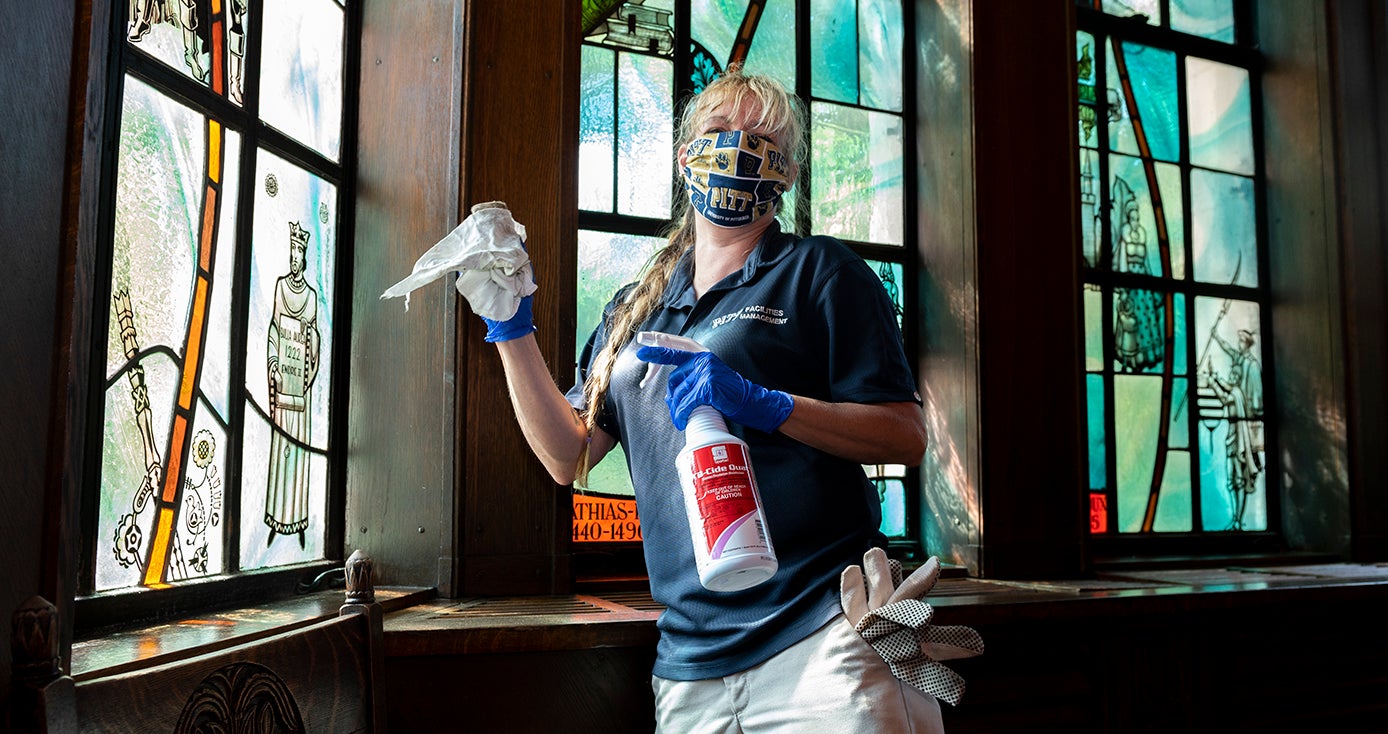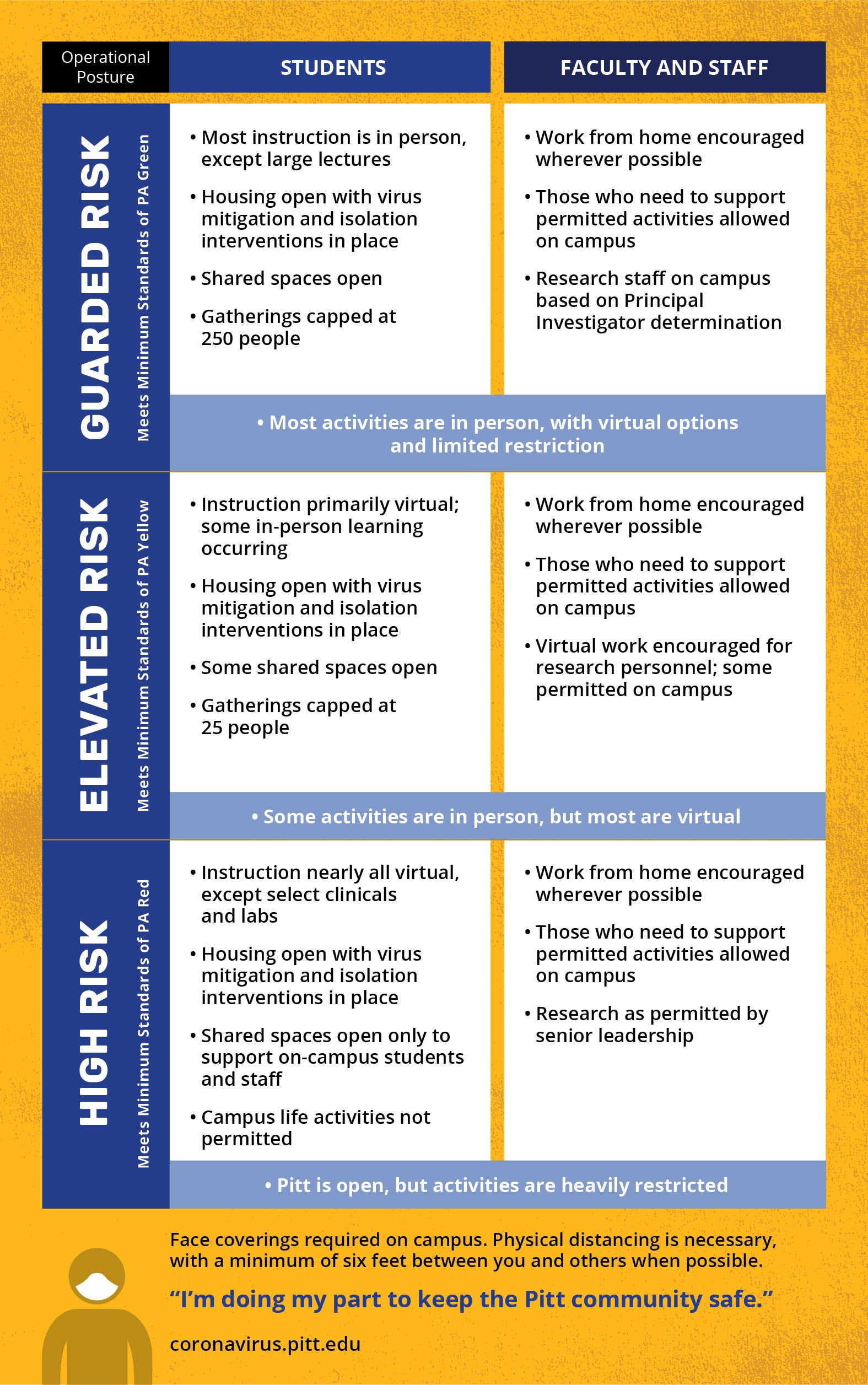
Subscribe to Pittwire Today
Get the most interesting and important stories from the University of Pittsburgh.Framework Provides Structure for an On-campus Experience This Fall
Pitt students, faculty, staff and families are getting the first look at what an on-campus experience will look and feel like when some faculty and staff return to on-campus work and students are welcomed back for the fall.
Today, the University shared details about the proactive planning to anticipate COVID-19 outbreak events and issues and prepare appropriately to reduce its disruptive impact on the community.
Focus and framework for planning
The Resilience Framework is the University’s shift from the emergency posture adopted in March to a new framework that combines constant monitoring of conditions on our campuses and the prevalence of the virus with a set of universal health rules to help keep us safe and foundational principles to guide our operations.
“This framework is not an emergency response plan. It's a management plan that we’ll use over the long term. It will help us stay flexible so that Pitt is still Pitt—regardless of what course this virus takes,” said Chancellor Patrick Gallagher in a video message.
“The goal—at every turn—is to maximize our mission while keeping our community members as safe as possible. And the Resilience Framework will be our guide for learning, serving and working over the next academic year,” said Gallagher.
Operational postures
Three distinct operational postures standardize Pitt’s response to evolving pandemic-related risks and set the boundaries for what campus operations look like and what action and behavior is allowable across Pitt people, places and programs.
On July 13, we plan to move from the emergency posture all of our campuses have been in since March to the Elevated Risk Posture on the Pittsburgh campus, and to the Guarded Risk Posture for our campuses in Bradford, Greensburg, Johnstown and Titusville.
Pitt’s Healthcare Advisory Group (HCAG) designed the postures with the goal of avoiding the need to go into lockdown mode where students are unable to be on campus, while recognizing that a return to “normal” pre-pandemic activity is not yet feasible. Read more about the Resilience Framework’s operational postures.
New rules
The University’s Healthcare Advisory Group established universal health rules to help keep us safe. These rules underpin the principles for planning and operations throughout all of our campuses and within each area. These principles—also referred to as standards and guidelines—will be developed and released over the coming weeks for seven areas: health; facilities; personnel; students; academics; research; and meetings, events and travel.
Among the initial health rules announced today are expectations for physical distancing and the use of face coverings and PPE and cleaning and interior ventilation. Regardless of the operational posture that the University is in, the following rules will help keep everyone safe:
- Face coverings: Wearing a face covering helps to protect people around you; they reduce the volume of respiratory droplets expelled during everyday interactions and human functions like talking, breathing, coughing, sneezing and laughing. As such, you will be required to wear a face covering on our campuses, specifically when in indoor or outdoor shared spaces and regardless of whether you are symptomatic.
- Physical distancing: Physical distancing is necessary, with a minimum of 6 feet between you and others when possible. Limit your time with others in small spaces like elevators and bathrooms. Gatherings should be held remotely, though capacity requirements vary by operational posture.
- Cleaning and interior ventilation: Everyone is required to practice good personal hygiene, including consistent hand washing and covering one’s face when they cough or sneeze. Pitt’s facilities management and custodial staff will continue their enhanced cleaning of all facilities, including housing, classrooms and offices; students, faculty and staff are responsible for enhanced cleaning of their work areas and shared spaces.
De-densifying campuses
Much of the focus in the planning has been how to responsibly bring students back to campus to live and learn safely. In order to accommodate this influx of on-campus activity, staff and faculty who can work from home are strongly encouraged to do so.
There are faculty and staff whose work directly supports on-campus students and operations, and their presence on campus is critical. The Flex @ Pitt instructional model and staggered shifts or alternating work days can help limit those on campus at any one time and will be managed through supervisors, deans and department chairs and approved by senior leadership.
More to come
In the coming weeks, information including additional principles and virus testing, symptom monitoring, quarantining and contact tracing will be released. Visit coronavirus.pitt.edu—the University’s planning and communication headquarters—for official up-to-date information.
Important upcoming dates
Watch Pittwire and visit coronavirus.pitt.edu for important information and weekly updates. While the course of University-wide planning may change, the anticipated schedule of major announcements includes the following (updated as of July 6):
Early July: More technology and space details for the Flex @ Pitt instructional model, additional information on housing, vulnerable populations, alternative enrollment options for international students and international travel safety guidance for students, faculty and staff.
Mid July: Additional information on Pitt Arrival, housing, scheduling and academic support, extracurricular activities and non-academic support, as well as principles for meetings, events and travel.
Late July: Virus testing, symptom monitoring, quarantining and contact tracing protocols.
More announcements, including updates to guidelines for research and parameters for working within our facilities, will also be announced throughout July.




